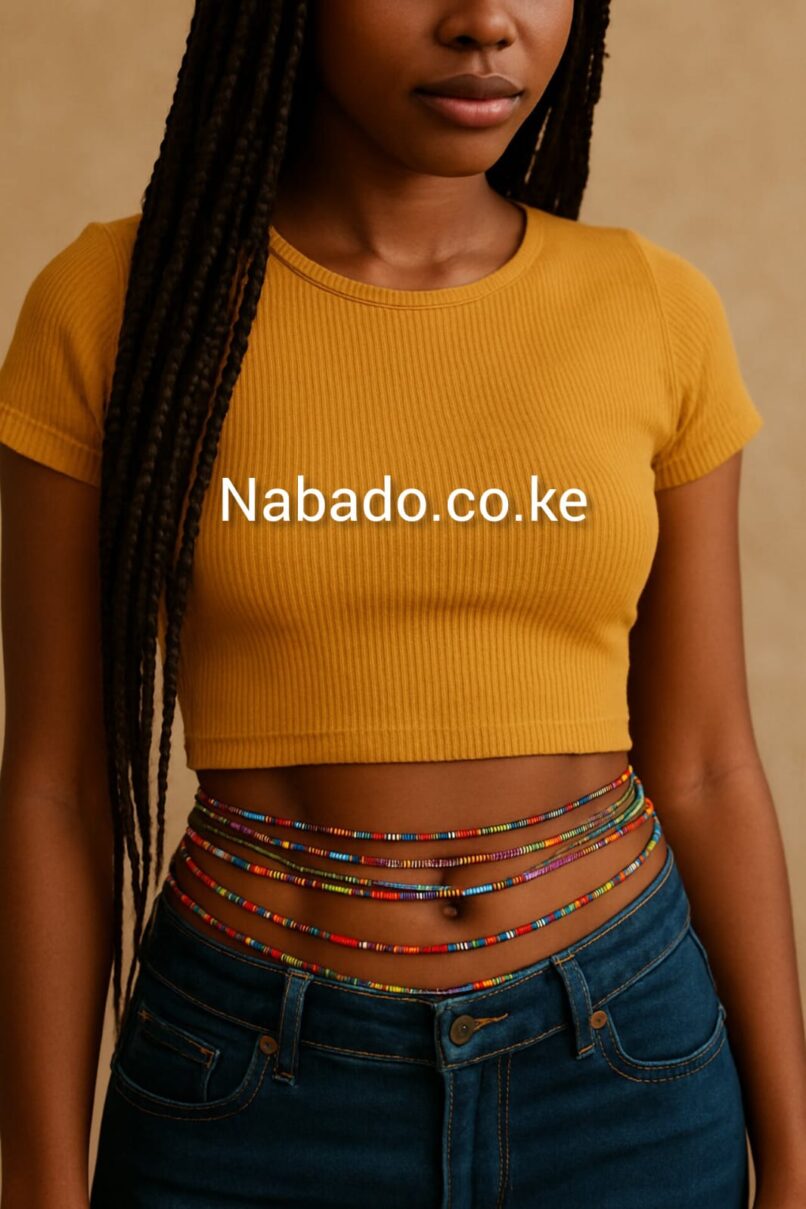
simply amazing, always for you.
Waist beads may look like simple strings of colorful beads tied around a girl’s waist, but they carry centuries of cultural significance, femininity, spiritual symbolism, and personal empowerment. From traditional African societies to modern fashion circles, waist beads have stood the test of time, evolving from sacred cultural artifacts to bold expressions of identity, sensuality, and style.

But why do girls wear waist beads? Is it for fashion, fitness, femininity—or something deeper?
In this in-depth guide, we explore the origin, meaning, and modern relevance of waist beads, diving into the cultural, spiritual, aesthetic, and personal reasons why girls of all backgrounds are embracing this powerful accessory.
1. The Historical and Cultural Roots of Waist Beads
Waist beads trace their origins to West Africa, particularly among ethnic groups like the Yoruba of Nigeria, the Ashanti of Ghana, and the Ewe of Togo. These cultures have long used waist beads in traditional ceremonies and as indicators of status, beauty, and maturity.
Historically, mothers would adorn their daughters with waist beads during rites of passage, particularly when the girls reached puberty. These beads were often made from glass, shells, cowries, or stones, each material and color holding specific cultural or spiritual significance.
Among the Yoruba, waist beads (called “Ileke” or “Jigida”) were a mark of femininity and sometimes used in spiritual rituals. In Ghana, waist beads (known as “Gebi” or “Djalé”) were linked to a woman’s social status, fertility, and sensuality.
Even today, in many African communities, waist beads are handed down from one generation to the next as a sacred cultural tradition.
2. Waist Beads as a Symbol of Femininity and Womanhood
One of the most traditional reasons girls wear waist beads is to celebrate their femininity and transition into womanhood. In many African communities, waist beads are introduced during a girl’s first menstruation as a rite of passage that marks her journey into maturity.
They serve as a quiet yet powerful acknowledgment of a girl’s fertility, grace, and readiness for womanhood. Some families even give multiple strands, each representing a new phase of life—from puberty to marriage to motherhood.

This intimate cultural practice isn’t just about marking time—it’s about honoring the natural beauty of the female form and the cycles it goes through.
3. A Tool for Body Awareness and Weight Monitoring
Waist beads are not just symbolic—they’re also practical. One reason many modern girls wear waist beads is to monitor weight changes naturally and discreetly.
Unlike elastic or adjustable clothing, waist beads are typically made with non-stretch cord. This means if a girl gains or loses weight, the beads either sit higher or lower on the waist—or become tighter or looser. This offers a gentle, body-positive way of tracking physical changes without stepping on a scale.
Rather than encouraging obsession with numbers, waist beads promote body awareness and self-love, encouraging girls to tune into how their bodies feel, not just how they look.
4. Spiritual and Metaphysical Meaning
In African spirituality, waist beads are more than accessories—they are energy tools.
Some women wear waist beads for protection, fertility, or healing. Others may have specific crystals or charms woven into their beads to balance chakras, ward off evil, or enhance intuition. For instance:
- Blue beads may symbolize calmness and communication.
- Green beads are linked to fertility and growth.
- Red beads might stand for vitality and passion.
- Black beads are often worn for spiritual protection.
Girls who engage in meditation, ancestral practices, or energy work may wear waist beads that align with their personal or spiritual goals. These beads are often blessed or cleansed before being worn, making them powerful talismans of intention.
5. Waist Beads as a Form of Fashion and Self-Expression
Beyond their traditional and spiritual value, waist beads have exploded in popularity as a modern fashion statement.
Today, girls wear waist beads for the same reasons someone might wear jewelry: to feel beautiful, to express themselves, or to complement an outfit. With so many color combinations, bead types, and styles, waist beads allow for customization and creativity. Some girls choose vibrant beads that pop, while others go for minimal, elegant strands that whisper confidence.
You’ll find them worn:
- Under clothes as a private accessory.
- Over clothing at festivals, beaches, or dance events.
- Layered with other jewelry for a boho or Afrocentric vibe.
What makes them truly empowering is that they don’t follow fashion trends—they set them.
6. Enhancing Sensuality and Intimacy
For many girls, waist beads are a celebration of their sensuality. In many African cultures, they were worn exclusively under clothing and only revealed to intimate partners. The gentle sound of beads clinking or the soft feel against skin can be deeply alluring—creating a private connection between the wearer and her partner.
Today, many girls still embrace this tradition. Waist beads are sometimes used to enhance romance, boost sexual confidence, or simply feel more in touch with their sensual energy.
Unlike lingerie or typical “sexy” outfits, waist beads are subtle, sacred, and deeply personal.
7. Expression of Cultural Identity and Heritage
In a world where Western beauty standards often dominate, waist beads provide a powerful way for girls—especially those in the African diaspora—to reclaim their cultural identity.
Wearing waist beads is a way to stay connected to African ancestry, even if you were born thousands of miles away. For many, it’s a reminder of their roots, history, and traditions that deserve to be celebrated and preserved.
Girls who wear waist beads often do so with pride, not just for the beauty they bring, but for the stories they carry. They’re a visible form of cultural resistance and self-affirmation.
8. Personalization and Custom Meaning
Each strand of waist beads tells a story.
Girls often custom-make their waist beads or buy them from artisans who can tailor them to individual preferences. Some choose colors that reflect their zodiac signs, life goals, or affirmations. Others add charms that represent love, healing, strength, or protection.
Some examples of customized meaning include:
- White beads for purity or new beginnings.
- Gold beads for wealth, abundance, and ambition.
- Pink beads for love and softness.
Whether worn for a special reason or “just because,” waist beads allow girls to express themselves in ways that are meaningful, beautiful, and unique.
9. Waist Beads in the Modern World
Thanks to social media, waist beads have experienced a renaissance.
Platforms like Instagram, TikTok, and Pinterest are filled with tutorials, artisans, and influencers showcasing waist beads as part of wellness routines, fashion looks, and spiritual practices.
Even celebrities like Erykah Badu, Beyoncé, and Janelle Monáe have been spotted wearing them, further fueling their popularity.
Today’s waist beads are not confined to tradition—they’re infused with modern relevance, allowing girls across the globe to adapt and embrace them in their own way.
Whether you’re in Nairobi, New York, or Paris, there’s a good chance you’ve seen waist beads worn proudly and beautifully by women and girls of all backgrounds.
10. Myths and Misconceptions About Waist Beads
Despite their growing popularity, waist beads are sometimes misunderstood or unfairly judged.
Let’s clear up some common myths:
- “They are only for promiscuous girls.”
False. Waist beads have deep cultural, spiritual, and personal meaning. Wearing them doesn’t determine a person’s character or morality. - “Only married women or adults can wear them.”
While some traditions reserve them for mature women, many cultures give waist beads to girls during childhood or puberty. In modern use, anyone can wear them—regardless of age or marital status. - “It’s cultural appropriation to wear waist beads if you’re not African.”
This depends. If worn with respect, knowledge, and intention, waist beads can be worn by non-African girls, especially when bought from African artisans or worn in solidarity. However, wearing them without understanding their roots may be seen as disrespectful.
Ultimately, waist beads are about intentionality. Respecting their origins while celebrating their beauty is the best way to honor this tradition.
11. How to Choose and Wear Waist Beads
If you’re thinking of getting your first set of waist beads, here are a few tips:
- Choose your purpose. Are you wearing them for beauty, spirituality, weight tracking, or a milestone? Let that guide your choice.
- Pick meaningful colors. Look into color symbolism or choose what resonates with your energy.
- Decide on fit. Do you want adjustable beads or permanent tie-on strands? Tie-on beads are more traditional and can last for years.
- Support authentic artisans. Buy from African or diaspora-owned businesses when possible to ensure cultural respect and economic support.
Most importantly: wear them for yourself.
A Personal and Powerful Statement
Waist beads are more than a trend. They’re a legacy—a quiet celebration of femininity, strength, culture, and individuality. Girls wear waist beads for different reasons: some to connect with their ancestors, some to track their body journey, and others to simply feel beautiful in their own skin.
Whether hidden beneath clothing or worn boldly on display, waist beads empower girls to embrace who they are—sensual, sacred, strong, and seen.
So the next time you see those delicate strands around a girl’s waist, remember: you’re not just looking at beads. You’re witnessing a story—one bead at a time.

Support Our Website!
We appreciate your visit and hope you find our content valuable. If you’d like to support us further, please consider contributing through the TILL NUMBER: 9549825. Your support helps us keep delivering great content!
If you’d like to support Nabado from outside Kenya, we invite you to send your contributions through trusted third-party services such as Remitly, SendWave, or WorldRemit. These platforms are reliable and convenient for international money transfers.
Please use the following details when sending your support:
Phone Number: +254701838999
Recipient Name: Peterson Getuma Okemwa
We sincerely appreciate your generosity and support. Thank you for being part of this journey!
